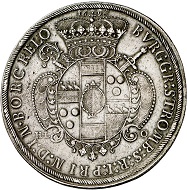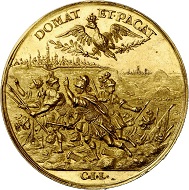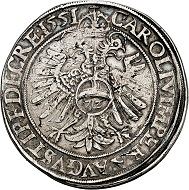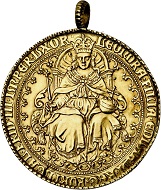26-06-2017 – 28-06-2017
Auctions 293-294
The Künker Summer Auctions
The auction house Künker will hold its Summer Auctions 293 and 294 from June 27 to 29, 2017, comprising more than 4.000 lots of coins and medals that cover the chronological range from medieval times to the present and the geographical range from Germany and Europe to overseas. The Werner Bröker Collection and the Bernd Terletzki Collection will be sold in Auction 293 “Coins and medals from medieval and modern times”. As always, an entire catalog is devoted to the gold strikings, post 1871-German coins and Russian coins and medals.
In addition, another part of the Horn Collection will be auctioned off on July 4-5, 2017. Precisely 1,000 world coins and medals, with a focus placed on the German states, will be called out as an eLive Auction on eLive-Auction.de.
Lot 29: Münster. Friedrich Christian von Plettenberg, 1688-1706. Reichstaler 1698, Münster. Very rare. Very fine. Estimate: 6,000 euros.
Germany
Auction 293 kicks off with the Werner Bröker Collection. The staunch citizen of Münster had specialized in the coinage of his native town, on Vatican coins and medals as well as medals related to the Peace of Westphalia. Adding to several rarities, a very rare 1698 reichstaler of the Bishop of Münster, Friedrich Christian von Plettenberg, will come under the hammer (Lot 29, VF, estimate: 6,000 euros).
Lot 3482: Augsburg. Gold medal of 8 ducats 1706 by C. J. Leherr on the relief of the cities of Augsburg and Ulm in 1704. Unique. Extremely fine to FDC. Estimate: 40,000 euros.
Ranging from Aachen to Würzburg, the coins from the German states have been estimated at three- to five-digit sums. Numerous attractive individual pieces and some interesting series, for instance from Brandenburg in Franconia, will be auctioned off. To mention only some spectacular gems: Two attractive Augsburg medals as cases in point: A silver medal of 4 talers from 1632, minted on the occasion of the surrender of the city to Gustavus Adolphus (Lot 104, EF, estimate: 10,000 euros), and the cover piece of Catalog 294, a unique gold medal of 8 ducats from 1706, issued to commemorate the relief of the cities of Augsburg and Ulm in the War of the Spanish Succession (Lot 3482, EF-FDC, estimate: 40,000 euros).
Lot 3494: Bavaria. Maximilian III Joseph, 1745-1777. Gold medal of 50 ducats no date (1759) by F. A. Schega on the Prince-Elector and his wife Maria Anna. Extremely rare. Extremely fine. Estimate: 75,000 euros.
Another magnificent medal had been made by F.A. Schega, chief medalist of Maximilian III Joseph, Prince-Elector of Bavaria. Manufactured shortly after the ruler’s marriage, it features the elaborate portraits of the bridal couple (Lot 3494, EF, estimate: 75,000 euros). The collector of Bavaria who does not want to spend that much can find a comprehensive series of river gold and ‘geschichtstaler’ (historical talers) in the Summer Auctions.
Lot 307: Brandenburg-Prussia. Joachim II, 1535-1571. Reichsguldiner 1551, Berlin. From the Henckel Collection, A. Weyl sale, Berlin 1876, No. 367. Extremely rare. Very fine. Estimate: 25,000 euros.
Fans of Brandenburg-Prussia should carefully examine the extremely rare reichsguldiner, minted by Joachim II in Berlin in 1551 with the title of Charles V (Lot 307, VF, estimate: 25,000 euros). Its provenance dates back as far as 1876! The 1727 reichstaler from Berlin (Lot 331, EF, estimate: 20,000 euros) and the 1687 ‘schiffsdukat’ (shipducat) of the Great Elector, minted from the gold that came from the Brandenburg colony in Guinea (Lot 3524, almost EF, estimate: 20,000 euros) are also extremely rare.
Lot 3681: Cologne. Joseph Klemens of Bavaria, 1714-1723. Ducat 1723, Bonn. Extremely rare. Extremely fine to FDC. Estimate: 25,000 euros.
As Archbishop of Cologne, Joseph Klemens of Bavaria minted an enchanting ducat, with a detailed depiction of the Adoration of the Magi on its reverse, in 1723. Künker offers this extremely rare piece in a perfect grade (Lot 3681, EF-FDC, estimate: 25,000 euros).
The County of Lippe is represented by a 1685 double reichstaler of the utmost rarity that was minted in Detmold (Lot 968, VF, estimate: 20,000 euros). A large series of Pomerania entails a 1 ½ reichstaler from 1613, minted in Stettin (Lot 1112, VF-EF, estimate: 25,000 euros). In her capacity as Abbess of Quedlinburg, Dorothea of Saxony was responsible for minting the 8 ducat piece that features her lavishly embellished coat of arms, as well as the Abbey’s founder, Henry the Fowler (Lot 3732, VF, estimate: 25,000 euros).
Lot 3794: Saxony. Cast gold bar no date (around 1850) in the weight of 246.68g with two multi-part dies in the crown oval. Extremely rare. Very fine. Estimate: 40,000 euros.
Made in the Kingdom of Saxony around 1850, a gold bar constitutes a particular rarity. The Saxon coat of arms which is stamped onto the bar probably indicated that this gold belonged to the Saxon treasury (Lot 3794, VF, estimate: 40,000 Euro).
Holy Roman Empire / Austria
A total of 274 lots with coins and medals of the Habsburgs, as Archdukes of Tyrol, as Emperors of both the Holy Roman Empire and Austria, as well as 58 lots of the Austrian Mediatized Houses make the major part of the two auction sales. This section also comes up with the coin with the highest pre-sale estimate: a 10 ducat piece from Vienna from 1656, offered as a set with an old collector’s note and a wooden box (Lot 3410, EF-FDC, estimate: 100,000 euros).
Lot 3400: Frederick III, 1440-1493. So-called ‘judenmedaille’ no date. (around 1600), unsigned. Very rare. Very fine to extremely fine. Estimate: 7,500 euros.
Bearing the portraits of Frederick III and Maximilian I, respectively, the two ‘judenmedaillen’ from around 1600 are of great historico-cultural significance (Lots 3400/3401, both VF-EF, estimate: 7,500 / 5,000 euros). And everybody interested in the history of the 19th century will be enthralled by the 1804 medal of Francis I. Weighing 24 ducats, it marks the elevation of Austria to an empire (Lot 3434, almost FDC, estimate: 25,000 euros).
Lot 1650: Leopold II, 1790-1792. ‘Königstaler’ for Hungary 1790, Vienna. Extremely rare in this grade. First strike. FDC. Estimate: 10,000 euros.
Numerous rarities can of course also be found among the silver pieces. One example should suffice: the outright perfect ‘königstaler’ that was struck in Vienna in 1790, to commemorate Leopold II being crowned King of Hungary (Lot 1650, EA, FDC, estimate: 10,000 euros).
Lot 3477: Fürstenberg. Karl Egon, 1729-1787. Ducat 1772, Prague. Extremely rare. Almost FDC. Estimate: 20,000 euros.
Let’s have a short look at the Austrian Mediatized Houses, too. They are represented by a small series of Salzburg coins and an extremely rare ducat of Karl Egon von Fürstenberg that was minted in Prague in 1772 (Lot 3477, almost FDC, estimate: 20,000 euros).
Lot 3208: Sweden. Charles X Gustav, 1654-1660. Ducat 1657, Stockholm. Extremely rare. Very fine to extremely fine. Estimate: 20,000 euros.
World coins and medals with a large series of Russia in Catalog 293
As usual with Künker, there is a huge offer of world coins and medals, for instance a very large series from Sweden. Here, we would like to single out a 1683 ducat of Charles X Gustav, minted in Stockholm in 1657 (Lot 3208, VF-EF, estimate: 20,000 euros).
Lot 3164: Netherlands / Campen. Double rosenoble no date (1600). Imitation of the sovereign of English Queen Elizabeth. Very rare. Extremely fine. Estimate: 60,000 euros.
Minted around 1600 in imitation of the sovereigns of English Queen Elizabeth, a double rosenoble from the Dutch city of Campen is highly likely to be the most spectacular foreign coin (Lot 3164, EF, estimate: 60,000 euros). However, some coins from the eastern part of Europe may very well compete with it for this title. A very rare Polish 1627 reichstaler from Bromberg is a worthy candidate, with only the monogram of Sigismund III on the obverse and the date encircled by a wreath on the reverse (Lot 2118, VF, estimate: 35,000 euros). Minted under John Kemeny in Klausenburg in 1661, an extremely rare ducat from Transylvania is also very promising in this regard (Lot 3303, EF, estimate: 35,000 euros).
Lot 5178: Russia. Nicholas I, 1825-1855. 50 zlotychs 1827, Warsaw, for Poland. Graded NGC MS 61. Only 299 specimens struck. Good extremely fine. Estimate: 50,000 euros.
Geographically speaking, we have just reached Russia. Almost 350 lots come from the Russian Empire, which, as always, offers several rarities, including a roubel of Ivan III from St. Petersburg from 1741 (Lot 5056, VF+, estimate: 30,000 euros), a platinum 6-roubel piece of Nicholas I, minted in St. Petersburg in 1834 (Lot 5130, proof, estimate: 25,000 euros), 50 zloytchs, minted in Warsaw in 1827 for Poland (Lot 5178, EF+, estimate: 50,000 euros), and a roubel of Nicholas II from 1911 in simply perfect condition (Lot 5286, proof, estimate: 25,000 euros).
Printed catalogs can be ordered at Künker, Nobbenburgerstr. 4a, 49 076 Osnabrück; phone: +49 541 96 202 0; fax: +49 541 96 202 22; or via e-mail.
You can find the auctions online, on the website of Künker.




























